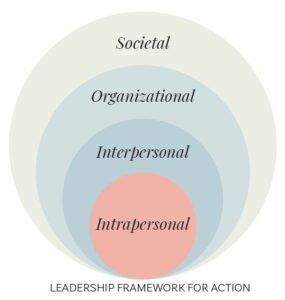Diversity, equity and inclusion (DEI) are needed to bring together the brightest minds to create solutions to business, economic, and social challenges of the 21st century and beyond. To achieve these outcomes will require the exercise of leadership. Inclusive leaders are needed to reimagine law firms, bar associations and corporations. This is a focus on celebrating differences, unveiling the limitless potential of each individual, and fostering multicultural teams.
 My Leadership Framework for Action provides a comprehensive approach for building the essential leadership competencies rooted in the principles of DEI, which manifests in healthy workplace relations, peak optimized performance, positive morale, and betterment of society. It provides four stages of learning: intrapersonal (engaging in self-discovery), interpersonal (building an authentic relationship with others), organizational (establishing strategic outcomes and promoting equity), and societal (developing sustainable, durable solutions). The following paragraphs provide a brief overview of each stage along with a self-reflection tool as a guided moment to pause, reflect and grow.
My Leadership Framework for Action provides a comprehensive approach for building the essential leadership competencies rooted in the principles of DEI, which manifests in healthy workplace relations, peak optimized performance, positive morale, and betterment of society. It provides four stages of learning: intrapersonal (engaging in self-discovery), interpersonal (building an authentic relationship with others), organizational (establishing strategic outcomes and promoting equity), and societal (developing sustainable, durable solutions). The following paragraphs provide a brief overview of each stage along with a self-reflection tool as a guided moment to pause, reflect and grow.
STAGE 1: INTRAPERSONAL (ENGAGING IN SELF-DISCOVERY)
Leadership development starts by looking within. What are the values, customs, beliefs and practices that have influenced you?
I refer to this personal narrative as your “leadership story.” One key dimension of your leadership story is your cultural background. This may include your age, race, ethnicity and gender. These dimensions of your identity shape who you are, inform your worldview, and guide your life’s journey. An effective leader is able to explore the multidimensional nature of one’s story while affirming the cultural experiences of others. An inclusive leader recognizes commonalities and differences while fostering mutual respect, affirming the cultural heritage of others, and building trust.
This requires an intentional focus on DEI. This is an ongoing process of self-reflection, learning and growth with the practice of cultural agility at its center. Being culturally agile focuses on your ability to develop self-awareness, be open to challenging your perspectives, and willingness to step outside your comfort zone.
To develop this competency, inclusive leaders engage in a process of self-discovery. One tool that I recommend helping you to explore your cultural background is the Diversity Wheel. You can use this tool as a team-building exercise. It will help you to gain a deeper understanding of your cultural roots while learning about the cultural traditions of a colleague or teammate. This will aid you in the process of building connections and finding common ground.
Pause. Reflect. Grow. Take the Implicit Association Test from Harvard. What lessons did you learn about racial bias? How can you use this experience to challenge bias in your personal and professional life?
STAGE 2: INTERPERSONAL (BUILDING AN AUTHENTIC RELATIONSHIP WITH OTHERS)
Thirty years ago, business scholars were predicting the future of the workforce of 2000 and beyond. They anticipated greater racial and ethnic diversity, intergenerational shifts, and new advancements in technology. Others described the multicultural nature of this new workforce as the browning (racially diverse) and graying (large demographic of Baby Boomers) of society. They also predicted the need for a radical transformation in management and leadership strategies in order to address the needs of diverse employees.
In Managing Workforce 2000: Gaining the Diversity Advantage, key areas of organizational change are outlined. This includes changes to the policies, procedures and systems to address the evolving needs of the emerging workforce. The outcome can then be described as the diversity advantage: “blending and capitalizing on the different skills and perspectives of the people and creating an organization where everyone gives his or her best.”
The organizational change can also encompass the power of inclusive excellence, as stated in the Denver University Diversity & Inclusion statement: “recognition that a community or institution’s success is dependent on how well it values, engages and includes the rich diversity.” Leaders who can tap into the diversity advantage can position their teams for success in all forms as materialized through inclusive excellence, from the intrinsic, immeasurable value of team cohesion to the quantifiable values of increased productivity and revenue.
Fast forward to today—the leaders who embraced diversity as an invaluable asset strengthened their teams by cultivating diverse talent, creating equal access to job opportunities, and embracing the power of innovation. While the leaders who failed to do so struggle to establish viable businesses and find their value proposition in our globalized economy.
Pause. Reflect. Grow. How would you rank the effectiveness of your team as it relates to inclusion on a 1–5 scale (1 = poor, 5 = exceptional)? If the number is not where you want your team to be, what can you do to improve your team dynamics? As you reflect upon these questions, read these quotes about the importance of teams:
- One head does not exchange ideas. — Ghanaian proverb
- If you want to go fast, go alone. If you want to go far, go together. — African proverb
STAGE 3: ORGANIZATIONAL (ESTABLISHING STRATEGIC OUTCOMES AND PROMOTING EQUITY)
Inclusion is not just a slogan or something done to “check a box.” It is an ongoing commitment to strengthening the value-added of diverse perspectives and fostering collective engagement.
Over the past decade, research has demonstrated how diversity makes us brighter by opening our eyes to new dimensions of thinking, creating and building together. Further, diversity positively impacts performance and drives revenue because diverse teams generate better decisions.
This is the value-added of diversity and inclusion. For instance, ethnically diverse companies were 35% more likely to outperform less diverse businesses. As explained in “A Great Place to Work for All: Better for Business, Better for People, Better for the World,” when racial gaps at work shrink, employees’ productivity, brand ambassadorship, and retention rates rise. Further, a 2016 study referenced in the book, found annual revenue was 24 percent higher for most inclusive workplaces than their peers (which lack a diverse workplace environment).
However, the report Women in the Workplace 2018, by McKinsey & Company in partnership with LeanIn. org, found that we have not yet fully maximized the transformative power of diversity: “around 20 percent of employees say that their company’s commitment to gender diversity feels like lip service.”
A Pew report, Women and Men in STEM Often at Odds over Workplace Equity, discovered about 22 percent of employees believe there is “too little focus” on racial and ethnic diversity in the workplace. This is evidence of a missed opportunity for leaders to tap into innovation (the business case/imperative) and build a more just and inclusive society (the moral case/imperative).
Pause. Reflect. Grow. How will you demonstrate your commitment to inclusion? Draft five ways you will take action. This may include hiring practices, retention strategies, community engagement efforts, and supplier diversity, to name a few.
STAGE 4 SOCIETAL (DEVELOPING SUSTAINABLE, DURABLE SOLUTIONS)
Leaders stand up and speak up for justice. Pioneering civil rights attorney, Charles Hamilton Houston reminded each one of us that we must be a “mouthpiece for justice and serve as a sentinel standing against what is wrong.”
When we think about this in the context of diversity and inclusion in the workplace, whether it be a lack of pay parity or career advancement for a particular diverse group, inclusive leaders are the mouthpiece for justice. They ask critical questions, analyze key metrics, and develop strategies for advancing inclusivity.
Next, Houston reminds us to be a sentinel guarding against what is wrong. What is a sentinel? One who stands guard, standing at the watchtower, who is observant and is looking at what is happening in society. This means leaders must be proactive in this struggle to make justice and equity come alive and not just state mere words. Leaders are urgently needed to address pressing social justice challenges like ending mass incarceration, bridging the justice gap, promoting environmental justice, and addressing health care disparities.
Pause. Reflect. Grow. What does an inclusive work environment look like? What does success look like in serving diverse clients? Create a vision of where you hope to be as an inclusive workplace in five, 10, 15 and 20 years.
A CALL TO ACTION
The effective exercise of leadership is a call to action each and every day. It requires deliberate and intentional action for justice and equity to materialize. I close with the words of retired Minnesota Supreme Court Justice Alan C. Page: “How we act today, and every day for the rest of our lives will define who we are.”
Today, we can make a commitment to serve as a leader who will make a difference in the world. Reimage yourself as an innovator, builder and change agent. Invest time and energy in:
- Engaging in ongoing self-reflection (Stage 1).
- Building collaborative relationships (Stage 2).
- Establishing inclusive organizations (Stage 3).
- Committing to the betterment of society (Stage 4).










